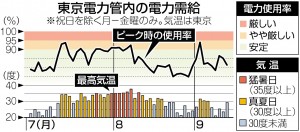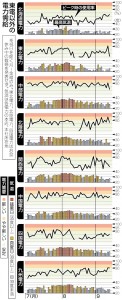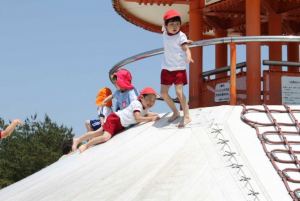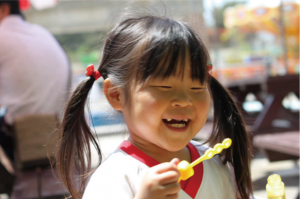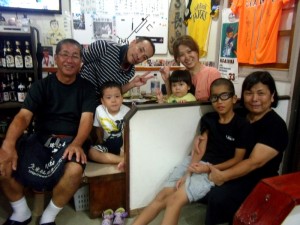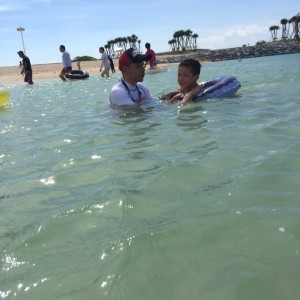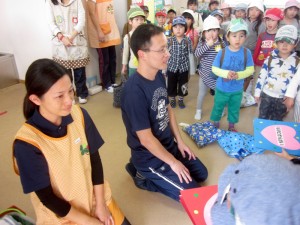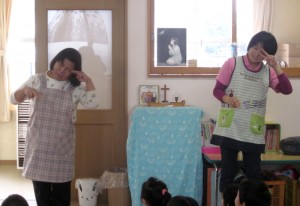Newsletter of the “Project on Nuclear Power and Radiation” — Part II of the “Let’s Walk Together” Project, the Anglican-Episcopal Church in Japan’s efforts to “walk together” with victims of the Great East Japan Earthquake of March 2011
“Let’s Walk Together” Project Part II Living Water
Volume 9, January 2016
http://www.nskk.org/province/genpatsugroup/English.html (Linked to the Provincial Office’s website) world without nuclear Anglican Search
(Translated into English from the original Japanese by Heeday.
The English translation edited by Rev. Dr. Henry French, ELCA, except for the donation information and the Project’s introduction)
No NPP, enough power
Revd. Makito John Aizawa, Chairperson, Steering Committee, Project on Nuclear Power and Radiation
I subscribe to two newspapers. One of them is the Tokyo Shimbun, which carried the article in the box below. As I read the article, I thought, “Just as I expected.” It confirmed that there is no need to generate electricity with nuclear energy. As I suspected, those calling for restarts of nuclear power plants (NPPs) actually want something other than electric power—they want money. The more NPPs work, the more money they make. And the local economies accommodating a NPP are dependent on those NPPs.
| Article: Surplus of power supply again, this summer [Article on p.1, September 28th, 2015 edition, Tokyo Shimbun] We asked the nine power companies of Japan having one NPP or more (Okinawa Electric has no NPP) about their peak-hour power consumption rates from July through September, 2015. Their power supply came from solar and thermal generation, as well as from selling/buying power between power companies. The Federation of Electric Power Companies of Japan says that energy saving played a major role in the supply-demand balance of the summer — |
Elsewhere, I read two other articles, one shocking and the other very convincing.
Tokyo Shimbun’s “Fudearai” editorial –
“In a crowded bus, a seated boy was reluctant to give his seat to the old man standing by him. Trying to talk some sense into the boy, the old man said, ‘Behave like that, and when you get old, no one will give you a seat.’ The boy talked back, saying ‘I will never get old!’ ‘Why not?’ asked the old man. The boy responded, ‘Because we are all dying soon.’ Following the Chernobyl disaster, conversations like this were heard in the area around the NPP.”
Asahi Shimbun’s “Tensei Jingo” editorial –
“A man was happily married to a lovely wife. One day, however, a dog barked at the wife and she showed her true identity – she was a fox who had turned herself into a female human. Of course, the man was shocked, knowing he had been deceived. Still, he was unable to give up the happiness he enjoyed while he was a fool. So, he asked the fox to turn herself into the same wife again. So goes a certain Buddhist teaching story. This fox can easily be replaced by a NPP. The Fukushima tragedy removed all the hocus-pocus of the NPP safety myth, and exposed what nuclear power truly is. Still, some are unable to surrender their addiction to NPPs and yearn to be fooled again.”
Another thought I have is that, though many talk about “safety,” the meaning of true “safety” has yet to be fully examined. If a way was found to process radioactive waste into something completely harmless, and if a feasible evacuation plan was developed in case of a major accident, then nuclear power generation might be permissible. The reality, though, is just the opposite. People often talk about accidents, but true safety should mean ultimately harmless waste from NPPs. A method for such final waste processing has never been invented.
This makes all the more important the plain fact that we have no power shortage without NPPs, and it should show us the way forward.
The Lord Jesus tells us to cherish and respect “life.” He is right in that. The Church exists for “life,” and interacts with the general society from that standpoint. We need electricity, but we need to recognize that there are many ways of generating electricity “safely.” We need to use our wisdom to proceed with a safe method of power generation.
| To donate to us: ◆ Postal transfer account with Japan Post: 00120-0-78536 Account holder: Nippon Sei Ko Kai (NSKK) Please clearly state in the transfer slip “Donation to the Project on Nuclear Power and Radiation Or: ◆ Account Name;NIPPON SEI KO KAI ◆ Address; 65 Yarai-cho, Shinjuku-ku,Tokyo 162-0805 JAPAN ◆ Account Number;4515547 ◆ Bank Name;The Bank of Tokyo-Mitsubishi UFJ, LTD. Branch Name;Iidabashi Bank Address;3-7 Kagurazaka, Shinjuku-ku,Tokyo 162-0825 JAPAN |
Message from the Support Team
~~ Reports on the “refresh” (retreat) programs of 2015 ~~
We held the programs described below, thanks to your prayers.
-
St. Paul’s Kindergarten, Koriyama
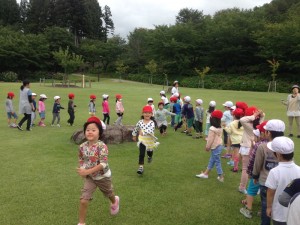
Kindergarteners running around as they want to, in Kamegajyou Park June: Visited Aquamarine Fukushima (Iwaki) and Spacepark (Koriyama)
August: Visited Kamegajyou Park (Inawashiro Town, Yama County)
September: Visited Spacepark (Koriyama)
October: Visited Kamegashiro Park (Inawashiro Town, Yama County)
November: “Rocket Crayon” concert, Kazumi Ushijima’s concert (from the Kyushu Diocese), visited Spacepark (Koriyama)Many children in Fukushima are still unable to play as they want to outdoors. They are not allowed to touch stones, plants, etc., found beside the streets. As a result, they experience problems like mental stress, obesity, and low athletic capabilities. Also, four years and nine months after the meltdown began, their parents are still living with tremendous anxiety over their children’s health. The kindergarten, as listed above, takes its children on excursions to let them play around outdoors, as they want to, in places with a low levels of radiation. Mother Nature helps to heal the mind and body, which are effectively “refreshed.” - “PAX” programs to help mothers raising their children
June: Babies’ yoga and massage class
October: Making fall aroma treatment cream
November: Babies’ yoga and massage class at Smile Square, St. Paul’s Kindergarten, Koriyama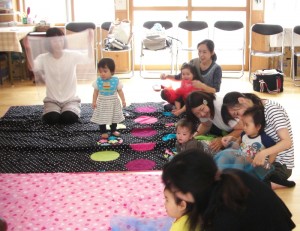
Mothers caressing their babies at the babies’ yoga and massage class. Both are very relaxed. -
St. Timothy’s Kindergarten, Onahama
May: Visited Hitachi Seaside Park (a park managed by the national government, Hitachi City)
October: Visited Okuhitachi Kiraranosato, an amusement park in Hitachi City
November: Visited Mushitec-Fukushima, a scientific facility (Sugakawa City)▼Kindergarteners playing around to their heart’s content, with lovely smiles, at Hitachi Seaside Park (a park managed by the national government).
-
-
Summer vacation programs
July to August: “Summer holidays in Takashima, a southern island in Nagasaki, Kyushu, Japan”

Targeted at children of kindergartens affiliated with the Anglican Church in Japan and their families, this program was made possible by the kind assistance of the Kyushu Diocese. In 2015, we held the fourth round of the program. The participants enjoyed a good, relaxing time, bathing at the beach, fishing, catching insects, and strolling around the island. The sea around Takashima accommodates fish of all colors and looks like a lovely aquarium. The kids fished, and volunteers from the Kyushu Diocese cooked the fish into fine dishes.
They also visited some famous sites around the island, such as tourism spots in the city of Nagasaki, on the islands of Io and Gunkan, and in other places. All the participants were fully refreshed in both body and mind.August 15th through 21st: “Fukushima refresh camp in Gifu 2015”
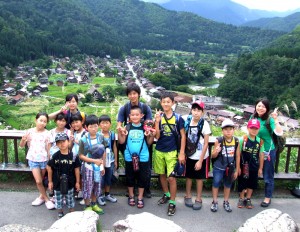
Shirakawa-go, Gifu Prefecture, a World Cultural Heritage Assisted by Nagoya Christian Community Center, a social welfare corporation, this camp was meant only for children. In 2015, they held the second round of the camp. The participating children savored nature’s fun fully, picking up beautiful pebbles, touching the grass and trees, playing in a crystal stream, and making precious friends. They learned many things, which should help them as they grow up. The seven-day camp gave the children experiences that were too precious to describe fully.
-
“One Family” Okinawa
August: “Home stay in Okinawa”
Dining at the Okinawa-style pub run by the director of the kindergarten they visited Splashing at “Emerald Beach” This was the first round of this program, thanks to help from the Okinawa Diocese. In the program, the Diocese’s clerics, laypeople, kindergarten/nursery staff, and the parents of kindergarteners hosted families from Fukushima in their homes. The participating children made friends with Okinawa’s children of similar ages and their families.
The hosting families of the Okinawa Diocese provided the best hospitality we have ever experienced. The participating families had a wonderful time, enjoying Okinawa’s beautiful nature and culture.June and October: Help to a nursery
In this program, whose fourth round was held in 2015, the Okinawa Diocese sent its nursery teachers to help at nurseries in Fukushima. We appreciate the Okinawa people’s understanding of and concerns about what is happening in Fukushima today. Also, with more rounds held, Fukushima and Okinawa are building strong mutual ties. In 2015, once again the teachers from Okinawa proved their sincere love to Fukushima, encouraging the nurseries’ staff and children to face tomorrow.
Project on Nuclear Power and Radiation
This project is run by a steering committee founded for the “Let’s Walk Together” Project and the 2012 General Synod resolution, “For a World without Nuclear Power Plants,” of the Anglican Episcopal Church in Japan (NSKK).
Steering committee members:Revd. Makito Aizawa, Revd. Akira Iwaki, Revd. Kenzo Koshiyama, Revd. Tazuru Sasamori, Ms. Hiroko Miyawaki
Secretary General: Ms. Kay Ikezumi
2-9-23, Hayama, Koriyama City, Fukushima Prefecture
Phone: +81-249-53-5987 Fax: 050-3411-7085
-
- “PAX” programs to help mothers raising their children
Four-walling of the motion picture,
“Nuclear Japan”
Eiichi Egawa, St. Peter’s Church, Asagaya, Tokyo
St. Peter’s Church, Asagaya, in the Tokyo Diocese, four-walled a motion picture titled “Nuclear Japan” in its hall, at 2pm, Sunday, July 26th, 2015. Amid the scorching heat, more than 40 people, including both members of the church and people from the general public, enthusiastically watched the movie, which runs longer than 2 hours. Prior to this, a group named “Shimin Seiji Kenkyukai” (Citizens’ Political Research Group) four-walled the same movie at “Rin’ya Kaikan” (Rin’ya Hall), Myogadani, Tokyo. The director, Mr. Hiroyuki Kawai, who is also an attorney, spoke on why he decided to direct the movie.The force commonly known as the “nuclear mafia”—consisting of the power companies and many key players from the political, bureaucratic, and business spheres—exercises its influences over many sectors in Japan. For this reason, though many cooperated in the movie’s production and distribution, all of them refused to have their identities published. Mr. Kawai, therefore, gave up on showing the movie at regular cinema theaters, and decided to depend on paid four-walling occasions nationwide.
After the 2011 earthquake and NPP meltdown, I was desperately searching for what I could do to help society get over the disaster, yet I was too busy to start anything at the time. Then, I saw this movie and spoke to my church’s priest, Revd. Nobuyuki Tamitsu, and the board of directors, hoping to show this movie at the church to let more people learn what happened and is happening in Fukushima. They agreed to four-wall the movie at the church.
If you want to hold a four-walling show of “Nuclear Japan,” please visit its website at http://www.nihontogenpatsu.com/
Sign of the Times
– Column on Current issues
“What Fukushima people are experiencing now”
Fumi Kawamori, staffer, Koriyama Office of the Project on Nuclear Power and Radiation
Soon, in March 2016, we will pass five years since the 2011 earthquake and meltdown. In Koriyama City, Fukushima, where I live, I find many people “losing sight of the 2011 tragedies” as time goes by.
Now, even residents in Fukushima are talking less about radiation and nuclear power. Possibly, this is because they take radiation risks for “granted,” as they live in Fukushima. In fact, however, in Koriyama we still have many “hot spots” here and there where the local radiation level is quite high. Also, TV and papers report every day on spatial radiation doses at many different places within Fukushima. Almost five years after the March 2011 disaster, we are not free from radiation. Living here, we have to “live with” radiation, although we wish for the normal life we enjoyed before the meltdown to be restored.
The other day, a news magazine was on my office desk. It reported on radiation exposure in Fukushima. A mother coincidentally found the magazine on my desk and became serious, saying, “Looking at things like this fills me with anxiety.” I did not know what to say. She actually wished to take her child out of Fukushima, and I knew that, yet for family issues or other reasons she had no other choice but to continue living in Fukushima with all of its solitude and anxiety. I decided not to disturb her like that again.
As I learn more about radioactive contamination here, and as I understand the people living here more, I find myself unable to say irresponsible consolations like “No problem.” Working with this Project, I have learned that indifference can be just as bad as doing harm.
As a staffer of the Project, I hope more people will become concerned over what is happening in Fukushima and over what nuclear power does to us. I also hope every single person will share my belief that everyone is responsible for building up peace.


